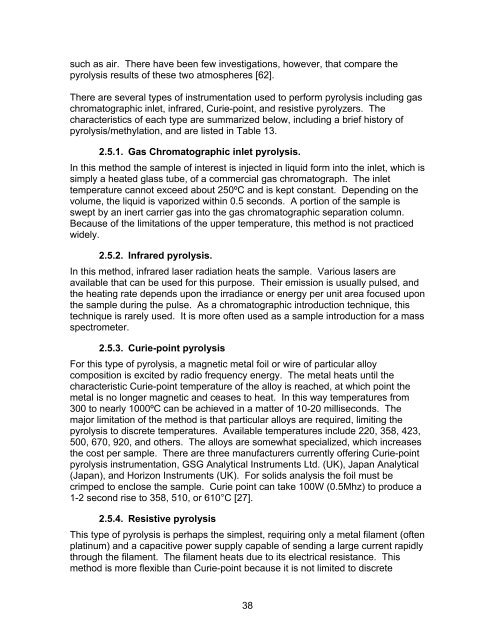Miniature Sensors for Biological Warfare Agents using Fatty Acid ...
Miniature Sensors for Biological Warfare Agents using Fatty Acid ...
Miniature Sensors for Biological Warfare Agents using Fatty Acid ...
You also want an ePaper? Increase the reach of your titles
YUMPU automatically turns print PDFs into web optimized ePapers that Google loves.
such as air. There have been few investigations, however, that compare the<br />
pyrolysis results of these two atmospheres [62].<br />
There are several types of instrumentation used to per<strong>for</strong>m pyrolysis including gas<br />
chromatographic inlet, infrared, Curie-point, and resistive pyrolyzers. The<br />
characteristics of each type are summarized below, including a brief history of<br />
pyrolysis/methylation, and are listed in Table 13.<br />
2.5.1. Gas Chromatographic inlet pyrolysis.<br />
In this method the sample of interest is injected in liquid <strong>for</strong>m into the inlet, which is<br />
simply a heated glass tube, of a commercial gas chromatograph. The inlet<br />
temperature cannot exceed about 250ºC and is kept constant. Depending on the<br />
volume, the liquid is vaporized within 0.5 seconds. A portion of the sample is<br />
swept by an inert carrier gas into the gas chromatographic separation column.<br />
Because of the limitations of the upper temperature, this method is not practiced<br />
widely.<br />
2.5.2. Infrared pyrolysis.<br />
In this method, infrared laser radiation heats the sample. Various lasers are<br />
available that can be used <strong>for</strong> this purpose. Their emission is usually pulsed, and<br />
the heating rate depends upon the irradiance or energy per unit area focused upon<br />
the sample during the pulse. As a chromatographic introduction technique, this<br />
technique is rarely used. It is more often used as a sample introduction <strong>for</strong> a mass<br />
spectrometer.<br />
2.5.3. Curie-point pyrolysis<br />
For this type of pyrolysis, a magnetic metal foil or wire of particular alloy<br />
composition is excited by radio frequency energy. The metal heats until the<br />
characteristic Curie-point temperature of the alloy is reached, at which point the<br />
metal is no longer magnetic and ceases to heat. In this way temperatures from<br />
300 to nearly 1000ºC can be achieved in a matter of 10-20 milliseconds. The<br />
major limitation of the method is that particular alloys are required, limiting the<br />
pyrolysis to discrete temperatures. Available temperatures include 220, 358, 423,<br />
500, 670, 920, and others. The alloys are somewhat specialized, which increases<br />
the cost per sample. There are three manufacturers currently offering Curie-point<br />
pyrolysis instrumentation, GSG Analytical Instruments Ltd. (UK), Japan Analytical<br />
(Japan), and Horizon Instruments (UK). For solids analysis the foil must be<br />
crimped to enclose the sample. Curie point can take 100W (0.5Mhz) to produce a<br />
1-2 second rise to 358, 510, or 610°C [27].<br />
2.5.4. Resistive pyrolysis<br />
This type of pyrolysis is perhaps the simplest, requiring only a metal filament (often<br />
platinum) and a capacitive power supply capable of sending a large current rapidly<br />
through the filament. The filament heats due to its electrical resistance. This<br />
method is more flexible than Curie-point because it is not limited to discrete<br />
38
















